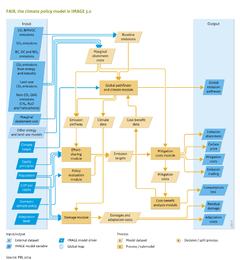Climate policy/Description: Difference between revisions
Jump to navigation
Jump to search
m (Text replace - "Marginal abatement cost" to "Marginal abatement costs") |
m (Text replace - "Van Vuuren et al., 2011" to "Van Vuuren et al., 2011a") |
||
| Line 1: | Line 1: | ||
{{ComponentDescriptionTemplate | {{ComponentDescriptionTemplate | ||
|Reference=Enerdata, 2010; Kindermann et al., 2008; Den Elzen et al., 2007; Van Vuuren et al., | |Reference=Enerdata, 2010; Kindermann et al., 2008; Den Elzen et al., 2007; Van Vuuren et al., 2011a; Meinshausen et al., 2011c; Hof et al., 2013; Hof et al., 2012; Den Elzen et al., 2012b; Den Elzen et al., 2012c; Den Elzen et al., 2011b; Hof et al., 2010; Hof et al., 2009; Roelfsema et al., 2013a; Roelfsema et al., 2013b; Den Elzen et al., 2013; De Bruin et al., 2009; | ||
|Description=In contrast to some of the other models in the IMAGE framework, [[FAIR model|FAIR]] is often used as a stand-alone model. However, if it is used as an integral part of the IMAGE framework, the model is tightly coupled to other parts of the framework. | |Description=In contrast to some of the other models in the IMAGE framework, [[FAIR model|FAIR]] is often used as a stand-alone model. However, if it is used as an integral part of the IMAGE framework, the model is tightly coupled to other parts of the framework. | ||
| Line 20: | Line 20: | ||
===Global pathfinder and climate module=== | ===Global pathfinder and climate module=== | ||
The pathfinder module [[FAIR-SiMCaP model|FAIR-SiMCaP*]] calculates global emission pathways that satisfy a long-term climate target ([[Den Elzen et al., 2007]]; [[Van Vliet et al., 2009]]; [[Van Vuuren et al., | The pathfinder module [[FAIR-SiMCaP model|FAIR-SiMCaP*]] calculates global emission pathways that satisfy a long-term climate target ([[Den Elzen et al., 2007]]; [[Van Vliet et al., 2009]]; [[Van Vuuren et al., 2011a]]) . Input are climate targets that are defined in terms of concentration levels, radiative forcing, temperature, or cumulative emissions. Intermediate restrictions on overshoot levels or intermediate emission targets representing climate policy progress also can be included. The model combines the mitigation costs model of FAIR and a module that minimises cumulative discounted mitigation costs by varying the timing of emission reductions. For the climate calculations, FAIR-SiMCaP uses the [[MAGICC model|MAGICC]] 6 model, with parameter settings calibrated to reproduce the medium response in terms of time scale and amplitude of 19 [[IPCC]] [[AR|AR4]] General Circulation Models ([[Meinshausen et al., 2011c]]). | ||
===Policy evaluation module=== | ===Policy evaluation module=== | ||
Revision as of 09:30, 2 May 2014
Parts of Climate policy/Description
| Component is implemented in: |
|
| Related IMAGE components |
| Models/Databases |
| Key publications |
| References |
|
